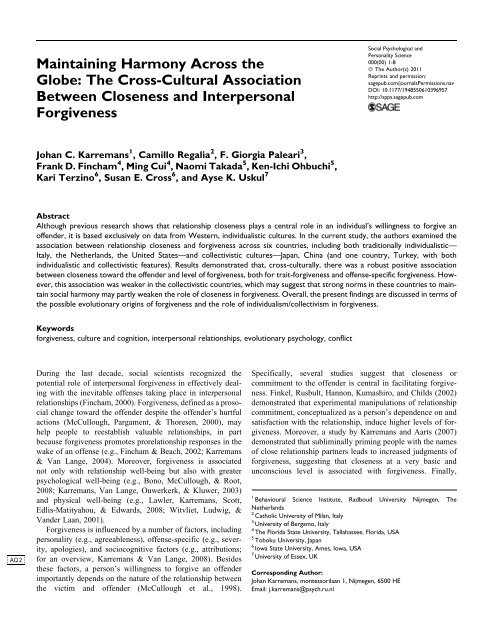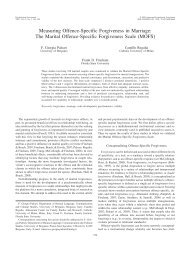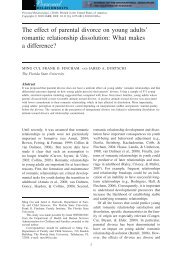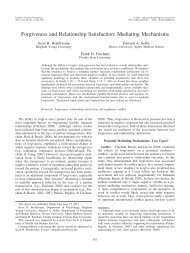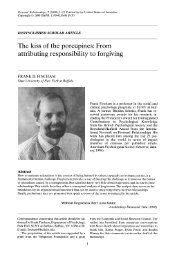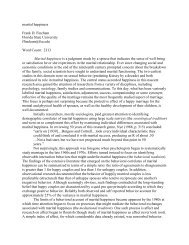Maintaining Harmony Across the Globe: The Cross ... - Fincham.info
Maintaining Harmony Across the Globe: The Cross ... - Fincham.info
Maintaining Harmony Across the Globe: The Cross ... - Fincham.info
Create successful ePaper yourself
Turn your PDF publications into a flip-book with our unique Google optimized e-Paper software.
<strong>Maintaining</strong> <strong>Harmony</strong> <strong>Across</strong> <strong>the</strong><strong>Globe</strong>: <strong>The</strong> <strong>Cross</strong>-Cultural AssociationBetween Closeness and InterpersonalForgivenessSocial Psychological andPersonality Science000(00) 1-8ª <strong>The</strong> Author(s) 2011Reprints and permission:sagepub.com/journalsPermissions.navDOI: 10.1177/1948550610396957http://spps.sagepub.comJohan C. Karremans 1 , Camillo Regalia 2 , F. Giorgia Paleari 3 ,Frank D. <strong>Fincham</strong> 4 , Ming Cui 4 , Naomi Takada 5 , Ken-Ichi Ohbuchi 5 ,Kari Terzino 6 , Susan E. <strong>Cross</strong> 6 , and Ayse K. Uskul 7AbstractAlthough previous research shows that relationship closeness plays a central role in an individual’s willingness to forgive anoffender, it is based exclusively on data from Western, individualistic cultures. In <strong>the</strong> current study, <strong>the</strong> authors examined <strong>the</strong>association between relationship closeness and forgiveness across six countries, including both traditionally individualistic—Italy, <strong>the</strong> Ne<strong>the</strong>rlands, <strong>the</strong> United States—and collectivistic cultures—Japan, China (and one country, Turkey, with bothindividualistic and collectivistic features). Results demonstrated that, cross-culturally, <strong>the</strong>re was a robust positive associationbetween closeness toward <strong>the</strong> offender and level of forgiveness, both for trait-forgiveness and offense-specific forgiveness. However,this association was weaker in <strong>the</strong> collectivistic countries, which may suggest that strong norms in <strong>the</strong>se countries to maintainsocial harmony may partly weaken <strong>the</strong> role of closeness in forgiveness. Overall, <strong>the</strong> present findings are discussed in terms of<strong>the</strong> possible evolutionary origins of forgiveness and <strong>the</strong> role of individualism/collectivism in forgiveness.Keywordsforgiveness, culture and cognition, interpersonal relationships, evolutionary psychology, conflictAQ 2During <strong>the</strong> last decade, social scientists recognized <strong>the</strong>potential role of interpersonal forgiveness in effectively dealingwith <strong>the</strong> inevitable offenses taking place in interpersonalrelationships (<strong>Fincham</strong>, 2000). Forgiveness, defined as a prosocialchange toward <strong>the</strong> offender despite <strong>the</strong> offender’s hurtfulactions (McCullough, Pargament, & Thoresen, 2000), mayhelp people to reestablish valuable relationships, in partbecause forgiveness promotes prorelationship responses in <strong>the</strong>wake of an offense (e.g., <strong>Fincham</strong> & Beach, 2002; Karremans& Van Lange, 2004). Moreover, forgiveness is associatednot only with relationship well-being but also with greaterpsychological well-being (e.g., Bono, McCullough, & Root,2008; Karremans, Van Lange, Ouwerkerk, & Kluwer, 2003)and physical well-being (e.g., Lawler, Karremans, Scott,Edlis-Matityahou, & Edwards, 2008; Witvliet, Ludwig, &Vander Laan, 2001).Forgiveness is influenced by a number of factors, includingpersonality (e.g., agreeableness), offense-specific (e.g., severity,apologies), and sociocognitive factors (e.g., attributions;for an overview, Karremans & Van Lange, 2008). Besides<strong>the</strong>se factors, a person’s willingness to forgive an offenderimportantly depends on <strong>the</strong> nature of <strong>the</strong> relationship between<strong>the</strong> victim and offender (McCullough et al., 1998).Specifically, several studies suggest that closeness orcommitment to <strong>the</strong> offender is central in facilitating forgiveness.Finkel, Rusbult, Hannon, Kumashiro, and Childs (2002)demonstrated that experimental manipulations of relationshipcommitment, conceptualized as a person’s dependence on andsatisfaction with <strong>the</strong> relationship, induce higher levels of forgiveness.Moreover, a study by Karremans and Aarts (2007)demonstrated that subliminally priming people with <strong>the</strong> namesof close relationship partners leads to increased judgments offorgiveness, suggesting that closeness at a very basic andunconscious level is associated with forgiveness. Finally,1 Behavioural Science Institute, Radboud University Nijmegen, <strong>The</strong>Ne<strong>the</strong>rlands2 Catholic University of Milan, Italy3 University of Bergamo, Italy4 <strong>The</strong> Florida State University, Tallahassee, Florida, USA5 Tohoku University, Japan6 Iowa State University, Ames, Iowa, USA7 University of Essex, UKCorresponding Author:Johan Karremans, montessorilaan 1, Nijmegen, 6500 HEEmail: j.karremans@psych.ru.nl
2 Social Psychological and Personality Science 000(00)o<strong>the</strong>rs have shown that forgiveness indeed helps in restoringclose bonds, as level of forgiveness regarding an offense ispositively related to post-offense level of closeness and satisfactionwith <strong>the</strong> offender (<strong>Fincham</strong>, Paleari, & Regalia, 2002;AQ 3 Karremans & Van Lange, 2008; McCullough et al., 1998;Paleari, Regalia, & <strong>Fincham</strong>, 2005).<strong>The</strong>se findings have been taken as suggestive evidence foran evolutionary functional perspective on forgiveness, asrecently postulated by McCullough (2008; McCullough,Kurzban, & Tabak, in press; cf., de Waal, 2000). Accordingto this view, forgiveness may have evolved because in our evolutionaryhistory humans ‘‘who deployed this strategy enjoyed<strong>the</strong> fitness benefits that came from restoring potentially valuablerelationships’’ (McCullough et al., in press). Close bondswith o<strong>the</strong>rs were vital to <strong>the</strong> survival and reproductive fitness ofour ancestors, for example through <strong>the</strong> provision of <strong>info</strong>rmationand resources, mates, and care for offspring. Hence, throughDarwinian selection, people have an evolved need to formclose bonds and have acquired a set of internal mechanisms tha<strong>the</strong>lp <strong>the</strong>m to maintain those bonds (Baumeister & Leary,1995). Given <strong>the</strong> inevitable conflicts and offenses takingplace within <strong>the</strong>se close relationships, <strong>the</strong> capacity to forgivemay be one such specific mechanism that helps people in sustaining<strong>the</strong>se bonds.This reasoning is strongly in line with <strong>the</strong> Valuable-Relationships Hypo<strong>the</strong>sis, which has received a fair amountof attention in <strong>the</strong> primate literature (Aureli, Cords, & vanSchaik, 2002; Watts, 2006). According to this hypo<strong>the</strong>sis, individualsare more likely to reconcile after conflict depending on<strong>the</strong> level of <strong>the</strong> ‘‘value’’ of <strong>the</strong> relationship. Ultimately relationshipvalue depends on <strong>the</strong> extent to which a relationshipprovides survival and reproductive benefits and can beacquired for example when <strong>the</strong> partner provides resources(e.g., for food) or safety, or for a number of o<strong>the</strong>r reasons(Watts, 2006). What is important here is that studies generallyhave found that, when two animals (primates, monkeys) havestrong affiliative ties, <strong>the</strong>y have a much stronger tendency toreconcile after conflict (e.g., Aureli, van Schaik, & van Hoof,1989; Cords & Thurnheer, 1993). Although reconciliationbehavior is only an indication of forgiveness, as one can neverbe sure whe<strong>the</strong>r apes indeed experience forgiveness in <strong>the</strong> psychologicalsense (de Waal & Pokorny, 2005), such findings arestrongly in line with <strong>the</strong> idea that forgiveness has evolved as away to repair and maintain close bonds.Although <strong>the</strong> strong link between closeness and forgivenessin studies with humans seems in line with <strong>the</strong> evolutionaryaccount (McCullough, 2008), all <strong>the</strong>se studies were conductedin Western populations, ei<strong>the</strong>r in <strong>the</strong> United States or WesternEurope. This raises <strong>the</strong> important question of whe<strong>the</strong>r <strong>the</strong> linkbetween closeness and forgiveness generalizes to o<strong>the</strong>r cultures,as an evolutionary explanation of forgiveness wouldpredict. However, it is also possible that <strong>the</strong> strong linkbetween closeness and forgiveness as found in Western countriesmight—at least in part, or additionally—be explained byculture-specific factors. As proposed previously (Sandage &Williamson, 2005), <strong>the</strong> individualism-collectivism dimensionmay be important in understanding forgiveness across cultures,and perhaps especially <strong>the</strong> role of closeness in forgiveness.People in individualistic cultures are focused to a relativelygreater extent on a fairly small number of close relationshippartners (Schwartz, 1990) and may <strong>the</strong>refore be more willingto forgive close as opposed to nonclose partners. Also, closeo<strong>the</strong>rs may become almost literally part of an individual’sself (Aron, Aron, & Smollan, 1992). This notion is reflectedin <strong>the</strong> way closeness to a relationship partner has beenconceptualized, and measured, in terms of self-o<strong>the</strong>r overlap(Aron et al., 1992). As close o<strong>the</strong>rs are so tightly related to<strong>the</strong> self, forgiving close o<strong>the</strong>rs, as compared to forgivingnonclose o<strong>the</strong>rs, may be especially beneficial to <strong>the</strong> self. Inline with this reasoning, research has demonstrated that—atleast in <strong>the</strong> United States and Western Europe—<strong>the</strong> beneficialeffects of forgiveness for <strong>the</strong> victim’s psychologicalwell-being are more pronounced if <strong>the</strong> offender is a closera<strong>the</strong>r than a nonclose o<strong>the</strong>r (Bono et al., 2008; Karremanset al., 2003).Whereas <strong>the</strong>re may be a stronger focus on close o<strong>the</strong>rs as<strong>the</strong> primary unit of relationships in individualistic cultures(Goodwin, 1999), collectivistic cultures are characterized bya strong focus on <strong>the</strong> group or society as a whole (Hofstede,1980; Triandis, 1995). Accordingly, collectivistic societiesgenerally emphasize group norms that promote social harmony(Markus & Kitayama, 1991). Such norms are likely toinfluence how people generally respond to and deal with conflict.For example, it has been found that in collectivisticcountries such as Japan people are relatively more concernedwith avoiding or resolving conflict in order to preserve socialharmony (see Hook, Worthington, & Utsey, 2009). This maysuggest that, once conflicts do arise, collectivism could promoteforgiveness as a way of maintaining social harmony(Fu, Watkins, & Hui, 2004; Sandage & Williamson, 2005).More importantly, it may also suggest that, unlike what hasbeen found in individualistic countries, forgiveness may notso much depend on <strong>the</strong> nature of <strong>the</strong> relationship between victimand offender. In collectivistic societies, people may inpart grant forgiveness because it is culturally expected (i.e.,to comply with <strong>the</strong> norm of social harmony), and it may <strong>the</strong>reforebe less important who <strong>the</strong> offender is. According to thisview, as compared to individualistic countries, in collectivisticsocieties forgiveness may be less dependent on <strong>the</strong> level ofcloseness between victim and offender.Although <strong>the</strong> <strong>the</strong>oretical and empirical literature on forgivenesshas expanded enormously in <strong>the</strong> past decade, only a handfulof studies have examined forgiveness in non-Westerncountries, and only a few studies have directly compared Western(individualistic) and non-Western (collectivistic) countries(for a recent overview, see Hook et al., 2009). <strong>The</strong>se studieshave demonstrated that <strong>the</strong>re are cross-cultural similarities(e.g., <strong>the</strong> role of apologies; Takaku, Weinder, & Ohbuchi,2001) but also cross-cultural differences in <strong>the</strong> correlates offorgiveness (e.g., attributions of controllability; Fukuno &Ohbuchi, 1998). However, no studies have explored <strong>the</strong> relativeimportance of closeness in forgiveness cross-culturally.
Karremans et al. 3AQ 4AQ 5<strong>The</strong> Present ResearchIn <strong>the</strong> present research, we examined <strong>the</strong> association betweencloseness and forgiveness across a number of countries thattraditionally endorse more collectivistic worldviews (Japan,China) or more individualistic worldviews (<strong>the</strong> Ne<strong>the</strong>rlands,United States, North-Italy). This classification is based onHofstede (2001) and Diener, Gohm, Suh, and Oishi (2000),who both reported indices of collectivism-individualism forover 40 societies across <strong>the</strong> world. In both <strong>the</strong>se studies, Japanand China scored below <strong>the</strong> mean of <strong>the</strong> index used, indicatingcollectivism; <strong>the</strong> United States, <strong>the</strong> Ne<strong>the</strong>rlands, and Italyscored well above <strong>the</strong> mean, indicating individualism. In anexploratory manner, we also included Turkey. Several studiessuggest that <strong>the</strong> Turkish culture holds both individualistic andcollectivistic elements and cannot be placed on one or <strong>the</strong>o<strong>the</strong>r side of <strong>the</strong> individualism-collectivism dichotomy (e.g.,Cukur, de Guzman, & Carlo, 2004; Goregenli, 1997;Uleman,Rhee, Bardoliwalla, Semin, & Toyama, 2000; Uskul, Hynie,& Lalonde, 2004).An evolutionary functional approach to forgiveness suggeststhat level of closeness to an offender is associated withforgiveness across cultures (both in <strong>the</strong> documented individualisticand collectivistic countries, and in Turkey). However, wesuggested that cultural differences may in part explain <strong>the</strong>central role of closeness in forgiveness as found in previousresearch in Western individualistic countries, and thatcloseness may be less central to forgiveness in collectivisticcountries (i.e., China and Japan). Thus, <strong>the</strong>re may be crossculturalvariation in <strong>the</strong> strength of this association that mightbe shaped by different worldviews between <strong>the</strong>se cultures.(Given <strong>the</strong> ambiguous status of Turkey on <strong>the</strong> individualismcollectivismdimension, this latter hypo<strong>the</strong>sis is less clear withregard to Turkey.)We employed two strategies to examine <strong>the</strong>se predictions insix countries by looking at general inclinations to forgive andoffense-specific forgiveness (which are generally not highlycorrelated; e.g., Allemand, Amberg, Zimprich, & <strong>Fincham</strong>,2007; Paleari et al., 2005). We measured participants’ generalinclinations to forgive close o<strong>the</strong>rs versus nonclose o<strong>the</strong>rs andexplored whe<strong>the</strong>r <strong>the</strong> countries differed in <strong>the</strong>ir general inclinationsto forgive close versus nonclose o<strong>the</strong>rs. In addition, participantswere asked to recall an offense and to indicate <strong>the</strong>irlevel of closeness with <strong>the</strong> offender and <strong>the</strong>ir level of forgivenessregarding this specific offense. Importantly, we examinedwhe<strong>the</strong>r closeness was linked to forgiveness while controllingfor o<strong>the</strong>r variables that have been found to be central in predictingforgiveness (i.e., time since <strong>the</strong> offense, severity of <strong>the</strong>offense, and <strong>the</strong> extent to which <strong>the</strong> offender apologized).MethodParticipantsA total of 1,060 participants participated in <strong>the</strong> study. Onehundred and fifty-seven Japanese (40.9% males, 59.1%females; M age ¼ 19.6), 135 Chinese (37% males, 63% females;M age ¼ 20.0), 141 Turkish (22.7% male, 77.3% females;M age ¼ 21.2), 120 Italian (31.7% males, 68.3% females;M age ¼ 21.6), 181 Dutch (23.8% males, 76.2% females; M age¼ 21.5), and 326 U.S. (31.6% male, 68.4% females; M age ¼19.5) university students participated in <strong>the</strong> study. In eachcountry, participants were recruited at a single university,except in <strong>the</strong> United States, where <strong>the</strong> sample consisted of studentsfrom two different universities (Florida and Iowa).Procedure and MaterialsParticipants were recruited at <strong>the</strong> university campuses (ei<strong>the</strong>rclasses, cafeterias, hallways, etc.). If <strong>the</strong>y agreed to participate,<strong>the</strong>y could fill in <strong>the</strong> questionnaire on <strong>the</strong> spot or were given aquestionnaire that <strong>the</strong>y could take home, fill out, and return at acentral place. <strong>The</strong> questionnaire was part of a larger project andcontained several parts that will not be fur<strong>the</strong>r discussed here.<strong>The</strong> original English version of <strong>the</strong> questionnaire was translatedinto Japanese, Chinese, Italian, Turkish, and Dutch, and<strong>the</strong>n back-translated into English by a second translator toensure compatibility and equivalence in meaning (Brislin,1986). Differences were discussed until a consensus translationwas obtained. <strong>The</strong> translated instruments were next checked forpreservation of meaning and cultural appropriateness (seebelow). For <strong>the</strong> purpose of <strong>the</strong> present study, participants completedseveral measures that are discussed below. As noted in<strong>the</strong> introduction, we employed two strategies to explore <strong>the</strong> roleof closeness in forgiveness.Strategy I: General inclinations to forgive close versus noncloseo<strong>the</strong>rs. In <strong>the</strong> first part of <strong>the</strong> questionnaire, participants indicated<strong>the</strong>ir general inclination to forgive a close o<strong>the</strong>r and <strong>the</strong>irgeneral inclination to forgive a nonclose o<strong>the</strong>r. Participantswere first instructed to think of a same-sex friend <strong>the</strong>y felt mostclose to and to write down <strong>the</strong> initials of this person. Afterdoing so, participants completed <strong>the</strong> General Inclination to Forgive(GIF) scale twice (Berry, Worthington, O’Connor, &Wade, 2005; 7 items, e.g., ‘‘I forgive him/her almost everything,’’‘‘If he/she treats me badly, I treat him/her <strong>the</strong> same’’[reverse-coded]). <strong>The</strong> first time, participants were instructedto complete <strong>the</strong> scale as it applied to <strong>the</strong> close o<strong>the</strong>r <strong>the</strong>y justnamed. Instructions stated that we were interested in how <strong>the</strong>participant would generally respond if <strong>the</strong> close o<strong>the</strong>r behavedoffensively towards him or her. <strong>The</strong> second time, scale instructionsstated that we were now interested in how <strong>the</strong> participantwould generally respond to offensive behavior of someone one<strong>the</strong>y did not feel close to.Strategy II: <strong>The</strong> role of closeness in forgiving a past offense. Laterin <strong>the</strong> questionnaire, participants were asked to recall aninstance in <strong>the</strong> past year when <strong>the</strong>y felt offended by someoneelse. <strong>The</strong>y were asked to think back to <strong>the</strong> most severe offenseand to briefly write down what happened.Participants indicated on two items <strong>the</strong> perceived severity(e.g., ‘‘How severe was <strong>the</strong> offense?’’ 1 ¼ not severe at all,7 ¼ extremely severe; Cronbach’s alphas .85). One itemmeasured how long ago <strong>the</strong> offense took place (in months).Level of perceived closeness was measured with <strong>the</strong> Inclusion
4 Social Psychological and Personality Science 000(00)AQ 6of O<strong>the</strong>r in <strong>the</strong> Self scale (Aron et al., 1992). This scale consistsof seven circle-pairs that differ in <strong>the</strong>ir level of overlap, fromnonoverlapping to almost complete overlap. Participantswere instructed to indicate which of <strong>the</strong>se circle pairs bestrepresented <strong>the</strong>ir relationship with <strong>the</strong> o<strong>the</strong>r person. Thissingle-item scale has been widely used in previous research asan indicator of experienced closeness and has been successfullyused in previous cross-cultural studies (Uskul et al., 2004).Next, participants rated <strong>the</strong> extent to which <strong>the</strong> offendertried to repair <strong>the</strong> harm that was done, on eight items (e.g.,‘‘Admitted regret,’’ ‘‘Showed remorse,’’ ‘‘Apologized’’).Finally, eight items measured level of forgiveness regarding <strong>the</strong>specific offense, fur<strong>the</strong>r referred to as <strong>the</strong> Offense-SpecificForgiveness (OF) questionnaire (e.g., ‘‘I easily forgave <strong>the</strong>offender,’’ ‘‘I do not hold a grudge against him/her’’; adaptedfrom Maio, Thomas, <strong>Fincham</strong>, & Carnelley, 2008). <strong>The</strong> repairand forgiveness items were scored on 7-points scales, rangingfrom 1 ¼ completely disagree to 7 ¼ completely agree.Data Analytic StrategyBefore testing our main predictions, we verified <strong>the</strong> equivalenceof <strong>the</strong> scales (Byrne & Watkins, 2003; Van de Vijver& Leung, 1997) to rule out <strong>the</strong> possibility that differencesobserved between countries were artifacts of measurementbias. Specifically, using multi-sample CFAs via EQS (Bentler,1995), we tested conceptual, configural, and metric equivalence(for details, see Meredith, 1993; van de Vijver & Leung,1997) for <strong>the</strong> GIF scale, <strong>the</strong> OF questionnaire, and <strong>the</strong> RepairStrategies (RS) questionnaire. 1General inclinations to forgive close versus nonclose o<strong>the</strong>rs.Conceptual and configural equivalence of <strong>the</strong> GIF close andGIF nonclose scales were evaluated by estimating a multigrouptwo-factor oblique model, in which (a) <strong>the</strong> seven items referringto a close o<strong>the</strong>r were allowed to load on one factor and <strong>the</strong>seven items referring to a nonclose o<strong>the</strong>r on ano<strong>the</strong>r factor and(b) errors of corresponding close and nonclose o<strong>the</strong>r items wereallowed to correlate. After removing <strong>the</strong> same two items from<strong>the</strong> close o<strong>the</strong>r and <strong>the</strong> nonclose o<strong>the</strong>r factor of <strong>the</strong> scale (i.e.,‘‘If he/she treats me badly, I treat him/her <strong>the</strong> same’’; ‘‘<strong>The</strong>reare some things for which I could never forgive <strong>the</strong> o<strong>the</strong>r person’’),<strong>the</strong> two-factor oblique model obtained a very good fit,R-w 2 (176) ¼ 266.3124, p ¼ .000, R-CFI ¼ .968, R-RMSEA¼ .022, and all of its item loadings were substantial andsignificant. <strong>The</strong> final scales used in <strong>the</strong> analysis included <strong>the</strong>remaining five items. <strong>The</strong>se findings indicate that <strong>the</strong> itemsused were meaningful and valid indicators of <strong>the</strong> construct inall six countries.Metric equivalence was tested by constraining allfactor loadings to be equal and examining <strong>the</strong> Lagrange Multipliertest and w 2 difference test. <strong>The</strong>se tests revealed a numberof items with differing factor loadings across <strong>the</strong> countries.Constraints on <strong>the</strong>se loadings were <strong>the</strong>n relaxed and <strong>the</strong> modelre-estimated. This model had good fit indices, R-w 2 (212) ¼328.416, p < .001, R-CFI ¼ .958, R-RMSEA ¼ .022, indicatingpartial metric equivalence for <strong>the</strong> GIF scale.Forgiveness for a past offense. Conceptual and configuralequivalence of <strong>the</strong> eight-item OF questionnaire was evaluatedby estimating a multigroup one-factor model, which yieldeda poor fit. Inspection of factor loadings and residual covariancesrevealed that <strong>the</strong> four reversed-coded items wereproblematic in all groups. Removing <strong>the</strong>se items yieldedan acceptable fit, R-w 2 (12) ¼ 58.92, p < .001, R-CFI ¼ .977,R-RMSEA ¼ .059, providing evidence for conceptual and configuralequivalence of <strong>the</strong> remaining four-item OF scale.Metric equivalence was tested by constraining all four factorloadings to be equal across <strong>the</strong> groups. Three items had differingfactor loadings at least in one sample. When constraints on<strong>the</strong>se loadings were relaxed and <strong>the</strong> model was re-estimated,<strong>the</strong> model fit was good, R-w 2 (24) ¼ 86.03, p < .001, R-CFI¼ .970, R-RMSEA ¼ .048, indicating partial metric equivalencefor <strong>the</strong> four-item version of <strong>the</strong> OF scale.Repair strategies. We finally tested conceptual and configuralequivalence of <strong>the</strong> eight-item RS questionnaire by estimatinga multigroup one-factor model, which obtained a good fit,R-w 2 (115) ¼ 399.81, p < .001, R-CFI ¼ .968, R-RMSEA ¼.047, indicating conceptual and configural invariance across<strong>the</strong> six groups.Metric equivalence was tested by constraining all factorloadings to be equal across <strong>the</strong> groups. <strong>The</strong> Lagrange Multipliertest and w 2 difference test indicated that four items haddiffering factor loadings across <strong>the</strong> countries. When constraintson <strong>the</strong>se loadings were relaxed and <strong>the</strong> model re-estimated,<strong>the</strong>re was a good fit to <strong>the</strong> data, R-w 2 (146) ¼ 471.10, p
Karremans et al. 5Table 1. Comparison <strong>Across</strong> Countries Between Inclinations to Forgive Close Versus Nonclose O<strong>the</strong>rsForgiving Close O<strong>the</strong>rForgiving Nonclose O<strong>the</strong>rCountry M SD M SD Mean Difference t Test dNe<strong>the</strong>rlands 5.11 0.88 3.17 1.03 1.93b 23.68** 1.76Italy 4.78 1.19 2.92 1.16 1.86b 14.17** 1.34Turkey 4.73 1.44 2.53 0.99 2.20b 17.59** 1.48China 4.93 1.14 3.86 1.30 1.07a 8.80** 0.76Japan 4.38 0.99 3.11 1.12 1.27a 13.69** 1.09United States 5.30 1.05 3.38 1.10 1.92b 27.18** 1.51** < .001. Significantly different mean differences are reported in different letters.Table 2. Correlations Between Interpersonal Forgiveness, Closeness, Severity, Time Since Offense (Time), and Repair StrategiesCountry Forgiveness Closeness Severity Time Repair StrategiesNe<strong>the</strong>rlands Forgiveness — .49** –.39** –.26** .56**Closeness — .02 –.08 .51**Severity — .21** –.01Time – –.06Repair strategies —Italy Forgiveness — .64** –.42** –.18 .47**Closeness — –.19* –.17 .59**Severity — .16 –.21*Time — –.06Repair strategies —Turkey Forgiveness — .53** –.19* .15 .39**Closeness — –.11 –.06 .47**Severity — .12 .02Time — .06Repair strategies —China Forgiveness — .30** –.20* –.08 .41**Closeness — –.08 –.17 .25**Severity — .02 –.04Time — –.03Repair strategies —Japan Forgiveness — .19* –.38** –.01 .28**Closeness — .09 –.06 .25**Severity — .19* .04Time — .06Repair strategies —United States Forgiveness — .45** –.40** –.08 .45**Closeness — –.08 .01 .53**Severity — .14* .06Time – .12*Repair strategies —An ANOVA on <strong>the</strong> difference scores between forgivingclose versus nonclose o<strong>the</strong>rs was subsequently performedto explore cultural differences in <strong>the</strong> magnitude of <strong>the</strong>difference between forgiving close o<strong>the</strong>rs versus noncloseo<strong>the</strong>rs. Findings showed a significant effect of country on differencescores, F(5, 1,401) ¼ 36.94, p < .001. According to<strong>the</strong> Sidak post hoc test, Japanese and Chinese samples’scores did not differ, but <strong>the</strong>ir difference scores weresignificantly lower than those obtained for Dutch, Italian,Turkish, and American participants. Thus, even though allparticipants were more likely to forgive close o<strong>the</strong>rs thannonclose o<strong>the</strong>rs, this effect was weaker among Japanese andChinese participants.We next tested <strong>the</strong> association between closeness and forgivenessfor a specific offense. Correlations (Table 2) showthat, across countries, forgiveness was associated with closeness,severity of offense, and repair strategies. As expected,higher levels of forgiveness were associated with more closeness(and with less severity and with more perceived repairattempts by <strong>the</strong> offender). Interestingly, and consistent with <strong>the</strong>relatively low differences between <strong>the</strong> general inclinations toforgive close versus nonclose o<strong>the</strong>rs in China and Japan, <strong>the</strong>
6 Social Psychological and Personality Science 000(00)lowest closeness-forgiveness correlations were found in <strong>the</strong>seEastern countries, with correlations of .19 and .30, respectively.In contrast, <strong>the</strong> correlations ranged from .45 (U.S.) to .64 (Italy)in <strong>the</strong> o<strong>the</strong>r countries. A Fisher test showed that <strong>the</strong>se differencesin <strong>the</strong> correlations between Eastern samples and Dutch,Italian, Turkish, and American samples were significant(respectively. F ¼ 3.12, p < .001, Cohen’s q ¼ .34; F ¼4.61, p < .001, Cohen’s q ¼ .57; F ¼ 3.39, p < .001, Cohen’sq ¼ .40; F ¼ 2.99, p < .001, Cohen’s q ¼ .29, for <strong>the</strong> Japanesesample; F ¼ 1.97, p < .05, Cohen’s q ¼ .23; F ¼ 3.53, p < .001,Cohen’s q ¼ .45; F ¼ 2.31, p < .05, Cohen’s q ¼ .28; F ¼ 1.70,p < .05, Cohen’s q ¼ .18, for <strong>the</strong> Chinese sample), while <strong>the</strong>rewas no significant difference in <strong>the</strong> correlations between Chineseand Japanese participants (F ¼ .99, ns). Importantly, <strong>the</strong>association between closeness and forgiveness remained significantin all cultural contexts after controlling for severityof offense, time since offense, and repair strategies. Notably,as in several previous studies (e.g., Cukur et al., 2004; Uskulet al., 2004), Turkey’s participants responded in line with traditionallyindividualistic countries.DiscussionResults from six countries, including both individualisticand collectivistic societies, provide support for <strong>the</strong> notion that<strong>the</strong> level of closeness between victim and offender is, crossculturally,associated with forgiveness. When <strong>the</strong>y reported <strong>the</strong>irgeneral inclination to forgive, in all countries participantsreported higher inclinations to forgive close o<strong>the</strong>rs as comparedto nonclose o<strong>the</strong>rs. In addition, when recalling a specific hurtfulincident, level of closeness with <strong>the</strong> offender was significantlypositively correlated with forgiveness in each country, even aftercontrolling for o<strong>the</strong>r variables that have been shown to bestrongly related to forgiveness (i.e., severity, apologies, and timesince <strong>the</strong> offense). Never<strong>the</strong>less, <strong>the</strong>re was some variability in<strong>the</strong> strength of this relationship, with <strong>the</strong> two collectivistic countries(China, Japan) yielding weaker associations between closenessand forgiveness on both measures of forgiveness.Before fur<strong>the</strong>r discussing <strong>the</strong>se cross-cultural differences,we would like to highlight that <strong>the</strong> fact that closeness wasassociated with forgiveness in all countries is strongly inline with an evolutionary functional analysis of forgiveness(McCullough, 2008). Ultimately, forgiveness may haveevolved to preserve close relationships—relationships that mayprovide fitness (i.e., survival and reproductive) benefits. <strong>The</strong>psychological experience of closeness may act as a cue of fitnessopportunities (McCullough, Kurzban, & Tabak, 2009That is, people generally feel close to <strong>the</strong>ir kin and <strong>the</strong>ir romanticrelationship partner, which has obvious fitness benefits, butalso to o<strong>the</strong>rs with whom <strong>the</strong>y share a history of beneficialinteractions (e.g., emotional and/or material support). Suchinteractions have been vital for survival in our evolutionarypast, but also today <strong>the</strong> psychological and health benefits ofclose and supportive o<strong>the</strong>rs are pervasive (e.g., Berkman,Glass, Brissette, & Seeman, 2000). As such, experiencedcloseness with an offender may have become a proximateAQ 7 ).driving force for forgiveness, <strong>the</strong>reby helping people to maintain<strong>the</strong>se important bonds.In considering our findings, it needs to borne in mind that<strong>the</strong> data are cross-sectional, and hence, we cannot be surewhe<strong>the</strong>r closeness leads to forgiveness, or vice versa. Basedon previous findings, and <strong>the</strong>oretically, we suggest that <strong>the</strong>arrow points in both directions. A study by Finkel et al.(2002) demonstrated that experimentally inducing closenessresulted in more forgiveness, while a study by Karremans andVan Lange (2008) showed that experimentally inducing relativelyhigh versus low levels of forgiveness lead to correspond-AQ 8ing levels of experienced closeness toward <strong>the</strong> offender.Probably, <strong>the</strong> association between closeness and forgivenessin <strong>the</strong> current study could be explained in terms of both <strong>the</strong>seeffects. Note that both causal effects are in line with an evolutionaryaccount of forgiveness. From this perspective, forgivenessis more likely to take place in close ra<strong>the</strong>r than noncloserelationships, and closeness should thus predict forgiveness.At <strong>the</strong> same time, forgiveness should repair levels of closenessbetween two people, and forgiveness should <strong>the</strong>refore also leadto an increase in closeness.We suggested that, because collectivistic cultural normsmay more strongly dictate forgiveness as a way of maintainingharmony, in collectivistic countries people may distinguish lessbetween forgiving close versus nonclose o<strong>the</strong>rs, as compared toindividualistic individuals. <strong>The</strong> weaker closeness-forgivenesslink in Japan and China may reflect this notion. Given <strong>the</strong>cross-sectional nature of our findings, it should be noted that<strong>the</strong> weaker association might also be due to <strong>the</strong> possibility thatcollectivists tend to maintain <strong>the</strong>ir level of closeness with anoffender largely independent of level of forgiveness. We suggest,however, that <strong>the</strong>re are good reasons to believe that <strong>the</strong>former explanation is more plausible. For example, in a recentstudy examining prototypical ideas about forgiveness, it wasfound that Japanese participants focused more on featuresrelated to social harmony, while American participantsfocused more on features of self-enhancement (i.e., ‘‘WhenI forgive, I feel good about myself’’; Terzino, <strong>Cross</strong>, Takada,& Ohbuchi, 2010). This suggests that motives to maintain harmonyindeed more strongly underlie forgiving tendencies incollectivistic societies. Accordingly, among collectivists,motives to follow <strong>the</strong> social harmony norm may partly ‘‘overrule’’<strong>the</strong> effects of experienced closeness on forgiveness.However, to provide conclusive evidence for this reasoning,future research may experimentally manipulate closeness tosee whe<strong>the</strong>r this indeed has a relativelyweakeffectonforgivenessin collectivistic countries.Previous findings suggest that in collectivistic societieswhere forgiveness is an expected cultural norm, individual personalitydifferences (like perceived closeness) may also be lessstrongly associated with forgiveness than in individualisticsocieties (see Hook et al., 2009). Interestingly, in a similarvein, a recent study demonstrated that within families, <strong>the</strong> associationbetween personality traits and forgiveness was weakerfor parents’ forgiveness of <strong>the</strong>ir children, than for parents’ forgivingof each o<strong>the</strong>r, or child’s forgiveness of <strong>the</strong> parent,
Karremans et al. 7AQ 9AQ 10suggesting <strong>the</strong> almost obligatory nature of child forgiveness(Maio et al., 2008). Toge<strong>the</strong>r with <strong>the</strong> current findings, suchfindings may suggest that in any instance in which forgivenessis perceived, normative (be it a cultural or relationship norm)characteristics of <strong>the</strong> victim (e.g., personality traits or subjectivefeelings of closeness with <strong>the</strong> offender) may play a relativelyweak role in forgiveness.Despite <strong>the</strong> fact that we found a robust closeness-forgivenesslink in all countries, an important question remaining is whe<strong>the</strong>r<strong>the</strong> forgiveness ratings reflect similar underlying processesacross cultures. A study by Huang and Enright (2000) examinedphysical indicators of negative affect (e.g., blood pressure,masked smile), while Taiwanese (collectivistic) participantstalked about a past offense. Participants who indicated that <strong>the</strong>yforgave because of cultural demands for group harmony, comparedto those who forgave for empathic o<strong>the</strong>r-oriented motives,displayed more signs of negative affect. Put differently, although<strong>the</strong>y reported high levels of forgiveness, <strong>the</strong>y showed emotionalsigns of unforgiveness. In line with this, it is possible that ourparticipants in collectivistic countries report forgiveness becauseit is expected from <strong>the</strong>m, ra<strong>the</strong>r than because <strong>the</strong>y actually experienceforgiveness in an emotional sense—perhaps less so thanparticipants in individualistic countries. This issue could notbe addressed in <strong>the</strong> present study but is an interesting topic forfur<strong>the</strong>r investigation.To conclude, <strong>the</strong> current study is one of <strong>the</strong> first studies toexamine forgiveness across a number of different societies thatdiffer in <strong>the</strong>ir level of individualism versus collectivism. Wefound that closeness was robustly (but not invariably) associatedwith forgiveness in all countries. <strong>The</strong>se findings are in linewith <strong>the</strong> notion that forgiveness is an evolved mechanism formaintaining and protecting close relationships from <strong>the</strong> inevitableinterpersonal hurts that may occur in <strong>the</strong>m. Without <strong>the</strong>ability to forgive, it is unlikely that relationships could mainta<strong>info</strong>r a long period of time—not in Western countries, notin Eastern countries.AcknowledgementsWe thank Sevtap Cinan and Zeynep Sunbay for <strong>the</strong>ir help with datacollection in Turkey and Thijs Verwijmeren for collecting <strong>the</strong> datain <strong>the</strong> Ne<strong>the</strong>rlands.Declaration of Conflicting Interests<strong>The</strong> authors declared that <strong>the</strong>y had no conflicts of interests withrespect to <strong>the</strong>ir authorship or <strong>the</strong> publication of this article.Financial Disclosure/Funding<strong>The</strong> author(s) received no financial support for <strong>the</strong> research and/orauthorship of this article.Note1. For details concerning <strong>the</strong> factor loadings for <strong>the</strong> scale items for allmeasures, please contact <strong>the</strong> first author.ReferencesAllemand, M., Amberg, I., Zimprich, D., & <strong>Fincham</strong>, F. D. (2007).<strong>The</strong> role of trait forgiveness and relationship satisfaction in episodicforgiveness. Journal of Social and Clinical Psychology, 26,199-217.Aron, A., Aron, E. N., & Smollan, D. (1992). Inclusion of o<strong>the</strong>r in <strong>the</strong>self scale and <strong>the</strong> structure of interpersonal closeness. Journal ofSocial and Psychological Psychology, 63, 596-612.Aureli, F., Cords, M., & van Schaik, C. P. (2002). Conflict resolutionfollowing aggression in gregarious animals: A predictive framework.Animal Behavior, 64, 325-343.Aureli, F., van Schaik, C. P., & van Hooff, J. A. R. A. M. (1989).Functional aspects of reconciliation among captive long-tailedmacaques (Macaca fascicularis). American Journal of Primatology,19, 39-51.Baumeister, R. F., & Leary, M. R. (1995). <strong>The</strong> need to belong: Desirefor interpersonal attachment as a fundamental human motivation.Psychological Bulletin, 117, 497-529.Berkman, L. F., Glass, T., Brissette, I., & Seeman, T. E. (2000). Fromsocial integration to health: Durkheim in <strong>the</strong> new millennium.Social Science Medicine, 51, 843-857.Berry, J. W., Worthington, E. L., O’Connor, L. E., & Wade, N. G.(2005). Forgivingness, vengeful rumination, and affective traits.Journal-of-Personality, 73, 183-225.Bono, G., McCullough, M. E., & Root, L. M. (2008). Forgiveness,feeling connected to o<strong>the</strong>rs, and well-being: Two longitudinal studies.Personality and Social Psychology Bulletin, 34, 182-195.Brislin, R. W. (1986). <strong>The</strong> wording and translation of research instruments.In W. J. Lonner & J. W. Berry (Eds.), Field methods incross-cultural research (pp. 137-164). Newbury Park, CA: Sage.Byrne, B. M., & Watkins, D. (2003). <strong>The</strong> issue of measurement invariancerevisited. Journal of <strong>Cross</strong>-Cultural Psychology, 34, 155-175.Cords, M., & Thurnheer, S. (1993). Reconciliation with valuable partnersby long-tailed macaques. Ethology, 93, 315-325.Cukur, C. S., de Guzman, M. R. T., & Carlo, G. (2004). Religiosity,values, and horizontal and vertical individualism-collectivism:A study of Turkey, <strong>the</strong> United States, and <strong>the</strong> Philippines. Journalof Social Psychology, 144, 613-634.de Waal, F. B. M. (2000). Primates—a natural heritage of conflict resolution.Science, 289, 586-590.de Waal, F. B. M., & Pokorny, J. J. (2005). Primate conflictresolution and its relation to human forgiveness. In E. L.Worthington Jr (Ed.), Handbook of forgiveness (pp. 17-32). NewYork: Brunner-Routledge.Diener, E., Gohm, C. L., Suh, E., & Oishi, S. (2000). Similarity of <strong>the</strong>relations between marital status and subjective well-being acrosscultures. Journal of <strong>Cross</strong>-Cultural Psychology, 31, 419-436.<strong>Fincham</strong>, F. D. (2000). <strong>The</strong> kiss of <strong>the</strong> porcupines: From attributingresponsibility to forgiving. Personal Relationships, 7, 1-23.<strong>Fincham</strong>, F. D., & Beach, S. R. H. (2002). Forgiveness in marriage:Implications for psychological aggression and constructive communication.Personal Relationships, 9, 239-251.<strong>Fincham</strong>, F. D., Paleari, F. G., & Regalia, C. (2002). Forgiveness inmarriage: <strong>The</strong> role of relationship quality, attributions, and empathy.Personal Relationships, 9, 27-37.
8 Social Psychological and Personality Science 000(00)Finkel, E. J., Rusbult, C. E., Hannon, P. A., Kumashiro, M., &Childs, N. M. (2002). Dealing with betrayal in close relationships:Does commitment promote forgiveness? Journal of Personalityand Social Psychology, 82, 956-974.Fu, H., Watkins, D., & Hui, E. K. P. (2004). Personality correlates of<strong>the</strong> disposition towards interpersonal forgiveness: A Chinese perspective.International Journal of Psychology, 39, 305-316.Fukuno, M., & Ohbuchi, K. (1998). How effective are differentaccounts of harm-doing in softening victim’s responses? A scenarioinvestigation of <strong>the</strong> effects of severity, relationship, and culture.Asian Journal of Social Psychology, 1, 167-178.Goodwin, R. (1999). Personal relationships across cultures. London:Routledge.Hofstede, G. (1980). Culture’s consequences. Beverly Hills, CA: Sage.Hofstede, G. (2001). Culture’s consequences: Comparing values,behaviors, institutions and organizations across nations. ThousandOaks, CA: Sage.Hook, J. N., Worthington, E. L. Jr., & Utsey, S. O. (2009). Collectivism,forgiveness, and social harmony. <strong>The</strong> Counseling Psychologist,37, 821-847.Huang, S. T., & Enright, R. D. (2000). Forgiveness and anger-relatedemotions in Taiwan: Implications for <strong>the</strong>rapy. Psycho<strong>the</strong>rapy, 37,71-79.Karremans, J. C., & Aarts, H. (2007). <strong>The</strong> role of automaticity in forgivingclose o<strong>the</strong>rs. Journal of Experimental Social Psychology,43, 902-917.Karremans, J. C., & Van Lange, P. A. M. (2004). Back to caring afterbeing hurt: <strong>The</strong> role of forgiveness. European Journal of SocialPsychology, 34, 207-227.Karremans, J. C., & Van Lange, P. A. M. (2008a). Forgiveness in personalrelationships: Its malleability and powerful consequences.European Review of Social Psychology, 19, 202-241.Karremans, J. C., & Van Lange, P. A. M. (2008b). <strong>The</strong> role of forgivenessin shifting from ‘‘me’’ to ‘‘we.’’ Self and Identity, 7, 75-88.Karremans, J. C., Van Lange, P. A. M., Ouwerkerk, J. W., &Kluwer, E. S. (2003). When forgiveness enhances psychologicalwell-being: <strong>The</strong> influence of interpersonal commitment. Journalof Personality and Social Psychology, 84, 1011-1026.Lawler, K. A., Karremans, J. C., Scott, C., Edlis-Matityahou, M., &Edwards, L. (2008). Forgiveness, physiological reactivity andhealth: <strong>The</strong> role of anger. International Journal of Psychophysiology,68, 51-58.Maio, G. R., Thomas, G., <strong>Fincham</strong>, F. D., & Carnelley, K. B. (2008).Unraveling <strong>the</strong> role of forgiveness in family relationships. Journalof Personality and Social Psychology, 94, 307-319.Markus, H. R., & Kitayama, S. (1991). Culture and <strong>the</strong> self: Implicationsfor cognition, emotion, and motivation. Psychological Review,98, 224-253.McCullough, M. E. (2008). Beyond revenge: <strong>The</strong> evolution of <strong>the</strong>forgiveness instinct. San Francisco: Jossey-Bass.McCullough, M. E., Pargament, K. I., & Thoresen, C. E. (2000). <strong>The</strong>psychology of forgiveness: History, conceptual issues, and overview.In M. McCullough, K. Pargament, & C. Thoresen (Eds.),Forgiving: <strong>The</strong>ory, research and practice (pp. 1-14). New York:Guilford.McCullough, M. E., Rachal, K. C., Sandage, S. J., Worthington, E. L.Jr., Wade Brown, S., & Hight, T. L. (1998). Interpersonalforgiving in close relationships: II. <strong>The</strong>oretical elaboration andmeasurement. Journal of Personality and Social Psychology, 75,1586-1603.Meredith, W. (1993). Measurement equivalence, factor analysis andfactorial equivalence. Psychometrika, 58, 525-543.Paleari, F. G., Regalia, C., & <strong>Fincham</strong>, F. (2005). Marital quality,forgiveness, empathy, and rumination: A longitudinal analysis.Personality and Social Psychology Bulletin, 31, 368-378.Sandage, S. J., & Williamson, I. (2005). Forgiveness in culturalcontext. In E. L. Worthington Jr (Ed.), Handbook of forgiveness(pp. 41-55). New York: Brunner-Routledge.Schwartz, S. H. (1990). Individualism-collectivism: Critique andproposed refinements. Journal of <strong>Cross</strong>-Cultural Psychology, 21,139-157.Singelis, T. M., Triandis, H. C., Bhawuk, D. S., & Gelfand, M. (1995).Horizontal and vertical dimensions of individualism and collectivism:A <strong>the</strong>oretical and measurement refinement. <strong>Cross</strong>-CulturalResearch, 29, 240-275.Takaku, S., Weinder, B., & Ohbuchi, K. (2001). A cross-culturalexamination of <strong>the</strong> effects of apology and perspective-taking onforgiveness. Journal of Language and Social Psychology, 20,144-166.Terzino, K. A., <strong>Cross</strong>, S. E., Takada, N., & Ohbuchi, K. (2010).A fresh look at forgiveness: A cultural perspective. Unpublishedmanuscript.Triandis, H. C. (1995). Individualism and collectivism. Boulder, CO:Westview.Uskul, A. K., Hynie, M., & Lalonde, R. N. (2004). Interdependence asa mediator between culture and interpersonal closeness for Euro-Canadians and Turks. Journal of <strong>Cross</strong>-Cultural Psychology, 35,174-191.Van de Vijver, F., & Leung, K. (1997). Methods and data analysis forcross-cultural research. Thousand Oaks, CA: Sage.Watts, D. P. (2006). Conflict resolution in chimpanzees and <strong>the</strong>Valuable-Relationships Hypo<strong>the</strong>sis. International Journal ofPrimatology, 27, 1337-1364.Witvliet, C. B., Ludwig, T., & Vander Laan, K. (2001). Granting forgivenessor harboring grudges: Implications for emotion, physiology,and health. Psychological Science, 12, 117-123.BiosAQ 11AQ 1


